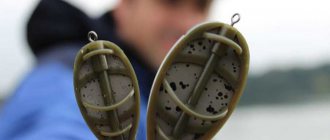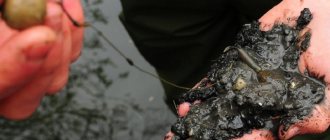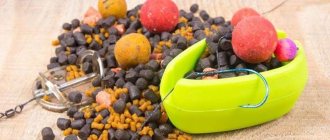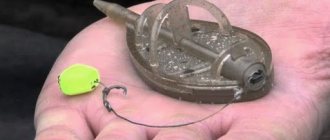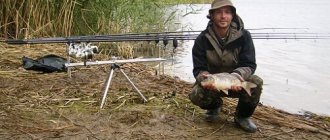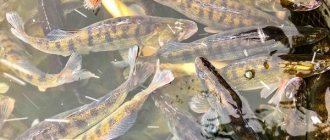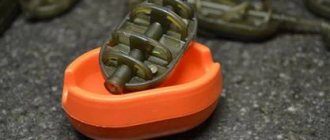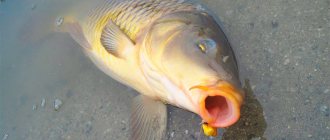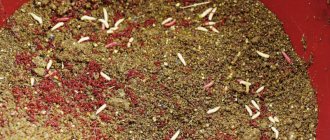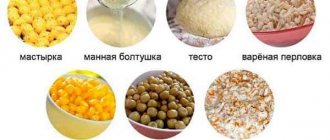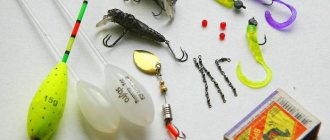The result of carp fishing depends significantly not on the luck of the fisherman, but on his knowledge of the features of carp fishing, as well as the correctly selected equipment that matches the conditions.
Fishing for carp using the method may remind most people of a familiar nipple or spring, but the efficiency is much better, this is explained by the special design of the method flat feeder.
The flat method is a feeder fishing method often used when fishing for carp. A distinctive feature of method fishing is the use of special method feeders (photo below). This method of fishing is characterized by economical and aggressive fishing - the carp is not fed kilograms of bait, as in classic carp fishing, but is economically fed with bait in the amount of feed. This allows you not to wait for the fish for hours in one place waiting for the carp to approach, but to start searching on your own. Karpolov is not tied to the feeding table.
Feeder used in the flat method
What is the flat method
The main feature of flat tackle is its design, the so-called method feeder, which is flat on one part. Moreover, its flat lower part has a lead base, and the frame itself for filling the bait is made of light plastic.
The lead base plays the role of a weight, while it allows for the only correct location of the spring after being thrown into the reservoir - with the metal plate straight down, while the plastic mesh with bait is located on top of the bottom of the reservoir.
The flat feeder is fixed to the main line either by a solid installation, when it does not move at all, or by sliding installation, during which the line passes through a tube in a spring and is not secured in any way. With a sliding fastening method, the feeder can move along the fishing line at a distance of up to half a meter.
Installation of the blind flat method used when fishing for carp
Attention: With the blind method of mounting equipment, the flat method implies self-hooking of the carp, therefore the weight of the spring for guaranteed hooking must be at least 50 grams. For sliding gear, which is designed for a more delicate bite, since the carp will not feel resistance in the process of swallowing the bait, you can choose less heavy springs.
The feeder method is equipped with one small leash, its length is usually 5-10 cm, with one hook at the end. The number of the latter is selected taking into account the bait used. Moreover, the hook with bait can either be inserted into the bait or be located near the feeder.
Pros and cons of carp fishing using the method
The design feature of the flat method feeder gives the equipment many advantages:
- the bait is always located on top , and the possibility that the spring will fall down with the hook, making it impossible to bite, is excluded;
- This method is convenient for fishing on ponds that have a muddy bottom or dense aquatic vegetation , since the even, wide shape of the spring prevents it from getting stuck;
- As with the installation of other types of feeders, when using this method, the bait goes directly to the fishing spot ;
- if you insert a hook with bait into the bait, then even after washing out the composition, the bait will be in a clean area , this gives a chance that the fish will swallow the offered delicacy;
- The flat method is good for catching carp in early spring , when a large amount of food for bait is contraindicated, since you can quickly overfeed the not yet active fish;
- Also, this option for installing the hook significantly reduces the number of rig flails .
Feeder filled with bait
The disadvantages of fishing using this method include the fact that the flat shape of the spring sometimes creates certain difficulties with casting accuracy. Moreover, the bait mixture is washed out more quickly from open-type feeders when fishing in rivers with strong currents; this also complicates the use of the method at depth.
Important: It is necessary to select certain types of feeders for method fishing when using them in different conditions for specific bodies of water.
Advantages and disadvantages of flat method equipment for carp fishing
The structural feature of the flat feeder gives the tackle a number of advantages when fishing for carp:
- The flat method is convenient for fishing in reservoirs with a silted or algae-covered bottom , since the flat, wide shape of the feeder allows them not to sink.
- The bait mixture is always at the top , which eliminates the possibility that the feeders fall with the hook down, making a bite impossible.
- When the hook with the bait is placed in the bait mixture, even after it is washed out, the hook remains lying on a clean area, leaving a chance for a bite. Also, this arrangement of the hook significantly reduces the number of hooks in the tackle.
- As with other types of feeders, when fishing with the flat method, the bait mixture is delivered directly to the casting point .
The disadvantages of the flat method include the fact that the flat shape of the feeder can create some problems with casting accuracy. Also, bait will quickly be washed out of open feeders when fishing for carp in reservoirs with strong currents ; this same feature complicates fishing at great depths.
Attention! Certain types of flat feeders should be selected for use in different fishing conditions.
Features and nuances of fishing for carp using the flat method
Depending on the characteristics of the reservoir in which fishing will be done, you should decide on the type of feeder and which one should be used.
The following main types of flat feeders are distinguished:
- Classic . These feeders have a classic open appearance, but may differ in the number of ribs in the frame for filling with bait mixture, weight, and shape of the base. Used when the carp is actively biting.
- Banjo . These feeders have small sides and are slightly lighter in weight than classic ones. Well suited for sliding installation with careful bites of carp.
- Scoop . Such flat feeders have a scoop shape, which makes them more convenient when fishing at great depths, since the bait mixture is not washed out so much when casting. As a rule, they are stuffed with pellets - industrially produced granular bait, but you can also use viscous bait made at home.
Sometimes feeder manufacturers produce special molds to make it easier to press bait into feeders.
When fishing for carp using the flat method, with close casts, you can use elastic monofilament for the equipment, but when increasing the casting distance, it is better to use braid. Some manufacturers also produce feeders with a rubber shock absorber, which dampens carp jerks, this is especially important when fishing near the shore.
Since small hooks are preferable for carp fishing, you should not skimp on this part of the equipment. It is better to choose products from well-known brands , avoiding counterfeits, as this will help to avoid unpleasant encounters with a broken hook or bad hooks.
Features of using method feeders
Taking into account the characteristics of the pond in which fishing will take place, you need to decide on the type of spring that you can choose for fishing.
Feeders method are of the following types:
- Classic . These are open springs that differ in the number of partitions on the plate for filling with bait, weight and size. Basically, this gear is used to catch carp using the flat method on the platform, where the density of fish is high and it is active.
- Scoop. These springs resemble the shape of a scoop, which made them more practical when fishing at depths, since the bait is not washed out so quickly after casting the tackle. Most often, they are filled with pellets - a bait composition in industrial granules, but they can also be filled with viscous mixtures prepared by yourself.
- Banjo . This design has small sides; the feeders are the lightest in weight, unlike other types. As a rule, they are used for sliding installation during careful carp bites.
Some feeder manufacturers provide specially designed molds to make it easier to stuff the bait mixture into the springs.
Form for putting food into the feeder
In the process of fishing using the method at short distances, a soft fishing line is used to rig the rod. But for significant casting distances, it is advisable to choose a braided cord. Also, certain companies make springs with a rubber shock absorber, which dampens the jerks of strong fish, especially when fishing for carp in early spring and summer from the shore.
Fishing for carp in early spring using the flat method:
Since catching carp or carp requires high-quality hooks, there is no need to try to save money on this element of equipment. It is recommended to select products from popular companies, avoiding counterfeits, as this will prevent many idle hooks or failures due to hook breakage.
Opening of the 2021 carp fishing season - carp fishing in early spring on a feeder flat using the following method:
How to use the flat feeder press mold?
So that our worm, maggot, or bloodworm cannot get out of the feeder before splashdown and is directly on the bait, it is necessary to compact it into the bait, which, first of all, must be of high quality in order to stand out against the background of the bottom.
It is worth taking a closer look at companies such as Sensas, Browning, Dynamite baits and Marcel VDE, they produce high-quality bait mixtures specifically for method fishing. Moreover, one such pack will serve several fishing trips. Non-method baits can be customized, for example, Fishdream, a wet feeder bait that works great in warm water when caramel is added to it.
The feeder bait method must first of all have a strong aroma so that the fish on the feeding spot can easily find our flat with bait. The bait in a flat feeder should disintegrate very slowly; do not forget that the flat is needed to highlight the bait in a common feeding spot, and not to feed the fish.
Method bait for the feeder should be small-fraction and large fraction in it, there is bait. When mixing bait for a flat feeder, you need to add water little by little, because... method mixtures stick well, and oversaturation of the bait with water will turn it into plasticine.
Important article on the topic: fishing using the method
Author of the article: Vitaly Leonidovich Ivanov, 2021.
What kind of rig is used when fishing with a method feeder: selection and production of equipment
Since the method usually uses a heavy feeder, you will need a shock leader to throw it. This is a piece of thick fishing line with a cross-section of 0.45 mm or cord 0.30 mm long, two sizes of the rod.
As the main line, you can use a regular monofilament with a cross-section of 0.30 mm or slightly smaller, or soft braid with a diameter of 0.22 mm. At the same time, when catching a trophy fish, you can fight with it with a high chance of successful fishing. But the fisherman can feel more confident only if there are about 5 turns of the shock leader on the spool.
The actual equipment when fishing using the method is very simple. At the end of the main line, a swivel is attached, a leash is fixed to it, in front of which there is a persistent stopper, and then a flat feeder. You can install a rear stopper, and then, on the pond itself, taking into account the circumstances, move it relative to the spring. That is, make a blind installation for self-cutting or a sliding one.
Installation inline method
Main equipment elements:
- rear and front stoppers;
- flat feeder;
- swivel at the end of the fishing line.
A leash is tied on a carabiner 15 cm long under the hair rig for corn or medium boilies, where a carp hook No. 6-10 is tied. You also need spare leashes with smaller hooks No. 14-18 for a worm or maggot.
However, method feeders from different manufacturing companies sometimes require special fastening and special installation. But, by and large, the meaning of fishing does not change.
In addition, we must not forget that method feeders can be of different sizes and vary in weight.
For example, now in stores you can find “micro-flat” ones weighing approximately 20 grams. These products are designed for catching small carp and crucian carp at short distances. Of course, they are not suitable for trophy fish. Long-range weighted springs with an increased volume for bait mixture and a weight of 80-100 grams will be much more effective.
How to make the snap method correctly, watch the video:
There are two types of flat installation:
1. Flat method, blind installation. The feeder stops on the feeder leash and works as a weight that hooks the fish on its own. For such fishing, you need to use feeders weighing 30 grams or more, so that self-hooking is more likely.
2. Inline flat method. The feeder feeder moves freely along the line, which eliminates the possibility of fish hooking itself. This flat method should be used when catching very cautious fish. Another option is to lock the feeder on the swivel that goes to the leash, or on the main cord or fishing line, with a rubber stopper.
What flat feeders are used? The most widespread companies at the moment are: Preston, Korum, Browning, Drenan and Technocarp.
Flat feeders from Preston come in two types, with a shock absorber (feeder rubber) and without a shock absorber (inline flat). We recommend using flat feeders with feeders if you have to fish with a braided line as a feeder base.
Such rubber dampens fish jerks well, which is very important especially near the shore. The use of a cord is justified when fishing has to be done at a great distance from the shore (50 meters or more).
The disadvantage of this flat feeder is the rubber, its quality is not the best, and if possible, replace it, especially when catching large fish such as carp, grass carp, and especially silver carp. Flat feeders are available weighing from 15 to 45 grams.
To make it more convenient to work with stuffing bait into the feeder, flat feeders come with press molds.
Feeders from a domestic manufacturer - Technocarp - are about three times cheaper than foreign analogues, but at the same time they fit well into an L-size mold. They are produced in weights up to 70 grams.
Green metal feeders have become very popular. Hooks, as you understand, must be strong and sharp; you should never skimp on fishing hooks, especially since their cost is not at all high.
It's worth taking a closer look at the hooks from Gamakatsu and Owner. You can use a monofilament line with a diameter of 0.22 mm, and a leash can be knitted from 0.18 or even 0.15 mm. If you have a braided cord as a base, you can use a 0.14 mm one.
Lures and Lures
Bait for catching carp using the flat method must meet certain conditions:
- have a strong attractive aroma for carp so that he can find it and the bait at the bottom of the pond;
- have sufficient viscosity to remain in the spring during casting and lowering it to the bottom of the pond;
- The bait composition for the method must lure fish better, unlike the starting one;
- the consistency of the bait mixture must be made such that it does not wash out within an hour after casting;
- have a small fraction so that the fish cannot quickly get enough, and thereby focus the carp’s attention on the large bait that is on the hook.
The bait at the bottom should be washed out gradually from the feeder.
You can use already prepared factory bait compositions, they also differ in viscosity, but if you wish, it is quite possible to make the bait yourself.
To make your own feeding mixture, you will need the following components:
- 1 kg of millet;
- 1 kg corn flour;
- 100 grams of canned corn;
- 100 grams of bran;
- 200 grams of milk powder.
Millet, flour, corn, and bran are cooked over a fire until they are completely boiled; powdered milk is poured in 10 minutes before readiness. Also, a small amount of honey is sometimes added to the already prepared bait mixture; it is the best flavoring agent for warm water.
Important: When cooking baits for carp fishing, it is necessary to ensure that they do not burn under any circumstances, as this significantly reduces the chances of bites.
As bait on the hook when fishing using the method, you can choose baits of animal or plant origin - peas, corn, worms, boilies, bloodworms, maggots and others, taking into account what exactly the carp likes in a particular pond at this time time.
Groundbait and maggots as bait
Fishing for carp using the flat feeder method, tackle, bait and fishing tactics using the Flat Method Feeder:
What bait and groundbait to use when catching carp on the flat
When fishing for carp using the flat method, the bait mixture must meet the following requirements:
- Be viscous enough to stay in the feeder when casting and delivering it to the bottom of the reservoir.
- Have a pronounced smell attractive to carp so that the fish can find it and the bait at the bottom of the reservoir.
- Be small-fractionated so that the carp cannot get enough of the bait, and thereby highlight a larger fraction of the bait on the hook.
- The consistency of the bait should be such that it does not wash out within 10-15 minutes after casting.
- The bait mixture for the feeder should attract carp better than the starter mixture.
You can use ready-made industrial bait mixtures, which can also vary in viscosity, but it is quite possible to prepare complementary foods at home.
To do this you need to take the following ingredients :
- 10 parts corn flour;
- 10 parts millet;
- 2 parts baby formula;
- 1 part wheat bran;
- 1 part minted canned corn;
Cook corn flour, millet, bran and corn until completely softened, shortly before being ready, add baby formula. also add a little honey to the finished bait as a flavoring .
Attention! When preparing bait mixtures for carp fishing, you need to ensure that the bait does not burn, as this will significantly reduce the number of bites.
When fishing for carp using the flat method, both plant and animal baits can be used as hook baits - corn, peas, boilies, worms, maggots, bloodworms and others, depending on what exactly the carp prefers in any particular body of water at a given time .
Method fishing technique
When catching fish using the method, first of all, you need to get acquainted with the features of the pond where you plan to fish - depth, flow speed, topography of the bottom plateau.
Before fishing, you need to start feeding the fish, and you must not forget that the starting bait composition must be inferior in attractiveness to the bait that will be introduced into the method.
You need to throw the equipment in one place - for which you select a landmark (for example, a tree or building) on the opposite bank and place a limiter on the spool for the cord or fishing line, so you can fix the distance of the thrown equipment.
You can choose a neutral bait, to which you can add different attractants already on the pond, selecting the most attractive ones for the carp.
Life hack. To find out the density of the prepared bait, you need to make a small ball out of it and throw it into a body of water right next to the shore, so you can determine how long it will take to wash it out with water.
Fishing for carp using the flat feeder method - expert video:
When fishing for carp or carp using the method, several fishing rods are often used at once - this makes it possible to fish a large area, and at the same time quickly determine which bait the fish prefers best. There is no need to recast often, once an hour is enough, since splashes will scare away cautious carp, especially when fishing in shallow water.
Special attention must be paid to bites. You should not react to barely noticeable impacts or vibration of the rod whip, of which there are always many during method fishing. Especially if sliding installation of equipment is used. These bites only mean that the carp is just trying the bait or has found it in the spring. You should expect a strong blow that will bend the rod blank.
When fishing using the method, the hook should be kept short, but at the same time sweeping. While fishing, try to be careful and attentive to the jerks of the carp. Any action by a fisherman against the movement of fish can cause loss of equipment and loss of prey.
